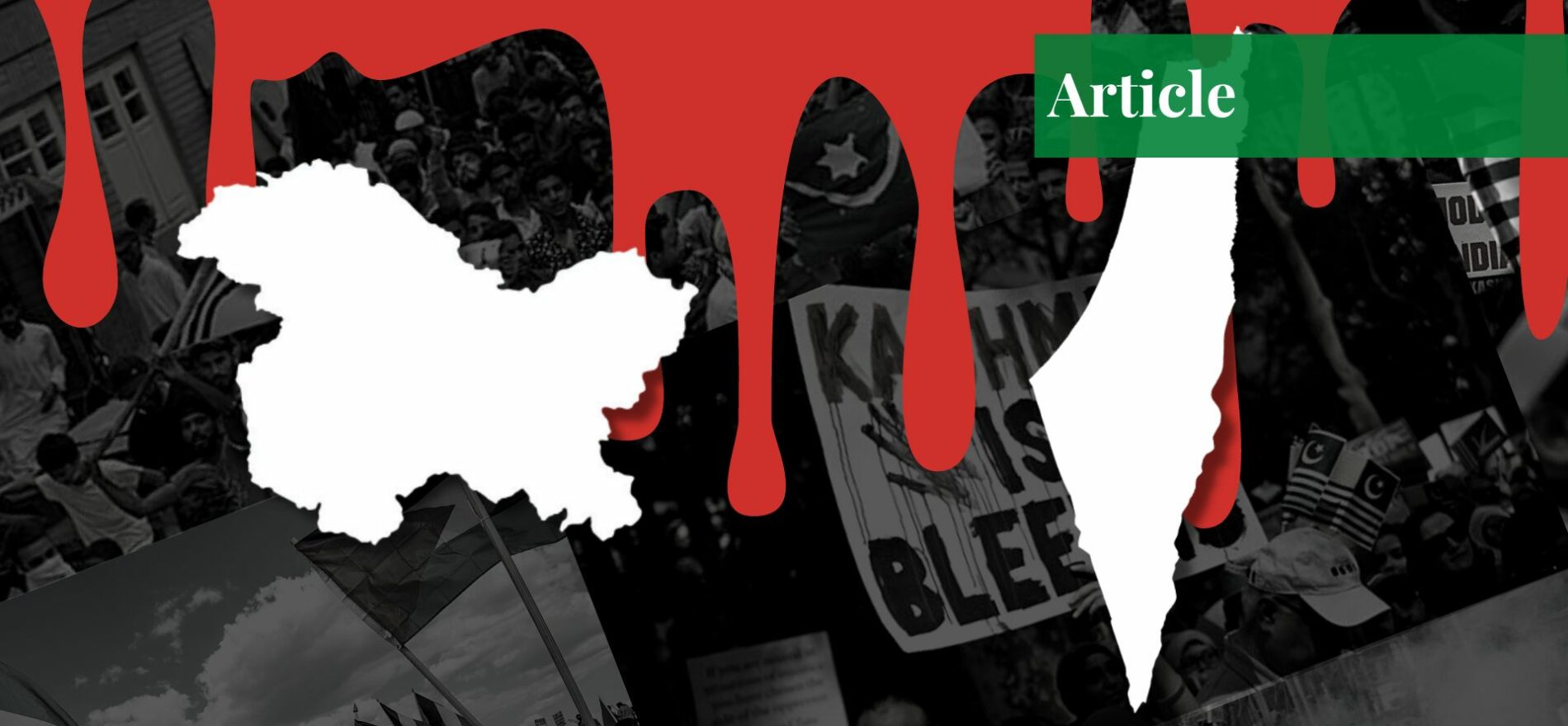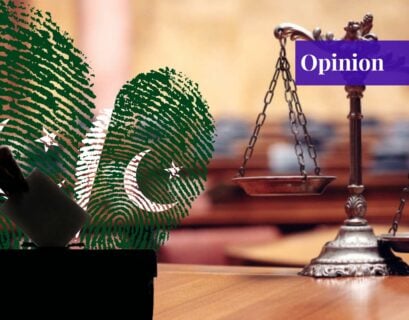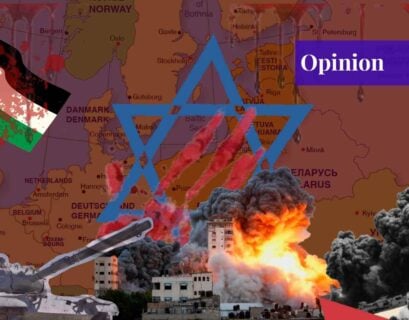Hafsa Ammar is a graduate of the National Defence University, Islamabad. Her areas of expertise are narrative building and propaganda warfare, centered around the Soviet Union and modern-day Russia.
Timeline
The conflicts surrounding Kashmir and Palestine came to fruition around the same time in the mid-nineties. The partition of Pakistan and India took place in 1947 in the month of August. The British Raj came to an end with a final master stroke of geographical divisions. The division was supposedly done after a careful perusal of the religious inclinations of the majority of people in each region or city. Muslim-populated areas leaned towards joining Pakistan and the Hindu majority with India.
Kashmir was a land of the Muslim majority and the people were willing to fall under the government of Pakistan. However, Indian claims came forth about the Maharaja Hari Singh of Kashmir signing the ‘Instrument of Accession’ to join India despite the massive Muslim majority. Significant controversy surrounds the Act, and many researchers have had their requests to view the original document refused. Kashmiri locals deny the existence of such a document to this day. Pakistan and India went to war over Kashmir in 1948, which led to the issue being raised by India in the UN.
Similar to Kashmir, Palestine, too, saw the beginning of its demise in the same time period, specifically in 1947 when the mandate passed to formulate Israel from the Jewish societies present within Palestine. This led to a sharp escalation of violence and aggression between the Arabs and Jews. The Nakba, the literal meaning of which is ‘catastrophe’, is the nightmare that ravaged the livelihoods of the Palestinians in May of 1948. Around 700,000-750,000, Palestinians were evicted from their lands by the Zionists.
Such uprooting is common to this day as it could be seen in the Sheikh Jarrah neighborhood in recent times as well. The Palestinians too faced conflict due to a document that did not have a local agreement tied into it, the Balfour Declaration signed by the British in 1917 gave fleeing Jews refuge in Palestine without the knowledge or permission of the Palestinians.
Actors
The actors involved in both situations have similar characteristics which are reflected in the paralleled trajectory of the conflicts. First, there is an overarching colonial power, the British crown, which plundered and owned land over which it had no actual authority.
Then come the primary actors, both India and Israel, the perpetrators of aggression, are regional powers with global support and strong enough economic ties to back up their military and political suppression of the opposition. Both Kashmir and Palestine are being strong-armed into giving up their territorial rights and are being targeted over their identity as Muslim-majority regions.
Geographical Significance
Both regions have hefty geographic importance. Palestine presents as a valuable crossroads between Africa and Asia. It is also religiously valuable to the major three monotheistic religions of the world: Islam, Christianity, and Judaism. Meanwhile, Kashmir is often referred to as the nuclear flashpoint in the region due to its significance to all three nuclear powers of Asia: China, India, and Pakistan. It also presents as a connecting bridge towards central Asia, an important trade route.
Ground Realities
Far-right conservative governments are ruled by religious fanaticism on both sides. Right-wing politicians such as Itamar Ben-Gvir and Modi are constantly visible on television and social media promoting harmful narratives against the respective repressed Muslim populations.
Human Rights Violations
Both regions have been torn asunder with gross human rights violations and war crimes from extrajudicial killings such as that of Javaid Ahmed Magray in Kashmir and police brutality of the Israeli Defence Forces to full-fledged massacres. The Kunan-Poshpora Massacre of Kashmir occurred in February of 1991; mass rapes and acts of sexual violence were enacted by armed Indian troops. Victims and their families still long for justice to this day.
The Deir Yassin Village massacre still haunts the psyche of the Palestinians. Occurring in April of 1948, women, children, fathers, and brothers – all were shot down by Zionist forces in the small village. Such tragedies are just a small blip amongst thousands of others.
Manipulation of Media
Gray and white propaganda has been used with a heavy hand to tarnish the freedom movements of both Palestine and Kashmir. A critical discourse analysis of TheTimesofIsrael media house shows words, phrases, and implications which are used to push forth the narrative that all Palestinians are terrorists and any statement that stands up against Zionism is anti-semitic.
The tragic murder of Shireen Abu Akleh was reported on 5th September 2022 as a ‘probability’ and an ‘accident’ by Israeli forces. The lack of accountability lessens the credibility of such media.
Kashmir is a target of black propaganda. Indian media focuses all its efforts on suppressing Kashmiri voices and blaming Pakistani agencies and forces for any disturbances or protests that take place in the occupied territory. Statements and press releases can flit between semi-truths and blatant lies.
Kashmir is not only suffering through a heavily militarized curfew but from a cutthroat e-curfew as well. An internet blockade in this day and age is crippling for any nation, more so for one that is already afflicted by such violence. Kashmiri journalists spoke up against this injustice as they said it made it difficult for them to not only report live incidents but also created a maelstrom of disinformation due to time gaps and inaccuracies.
Lack of Recognition for Governmental Structure
After decades of struggle, both Kashmir and Palestine have displayed active resistance against the oppression. They have governmental structures which are unfortunately not given much, if any, recognition at the international level. Any evidence of Kashmiri authority and special status was shattered once India revoked Article 370. While the Palestinian Authority is often referred to as a puppet of the terror outfit Hamas, which it is not. Any sign of protest by the locals is deemed a terrorist act and dealt with so much aggression that most of the population lives in a constant traumatic state.
Role of International Community
The forum of the United Nations is globally viewed as a platform for humanitarian causes, but when deconstructed, much of its resolutions and missions end up being useless. In 1948, the Kashmir issue was raised in front of the United Nations Security Council which came forth with UNSC Resolution 47.
The UN intervention was based on informal mediation and attempts to secure a ceasefire between Pakistan and India and eventually assure some sort of a demilitarized zone. The resolution underlined the need for a referendum, to figure out the inclination of the Kashmiris however, it was never undertaken.
Similarly, many resolutions were put out in hopes of resolving the Palestinian conflict such as Resolution 181 (II) which brought out a plan of removing the ‘Mandatory Power’ – the UK from Palestine, leaving it to form a future government with a stable economic structure. It was essentially a two-state solution as it called for the partition of Palestine into two – an Arab and Jewish state along with an independent Jerusalem. Instead of abiding by the resolution, Israel waged its war of independence in 1948 and invaded a majority of what was supposed to be Palestine.
The above-mentioned are not the only United Nations resolutions proposed for the Kashmir and Palestinian conflict but they are succinct statements of international attention toward the conflict or lack thereof. Bilateral negotiations between the governing bodies of primary nations involved in the conflict are the ideal way out in such complex circumstances but the chances of that happening are almost negligible due to the massive inequality of status quo and power present between both Palestine-Israel and India-Kashmir.
If you want to submit your articles, research papers, and book reviews, please check the Submissions page.
The views and opinions expressed in this article/paper are the author’s own and do not necessarily reflect the editorial position of Paradigm Shift.


















